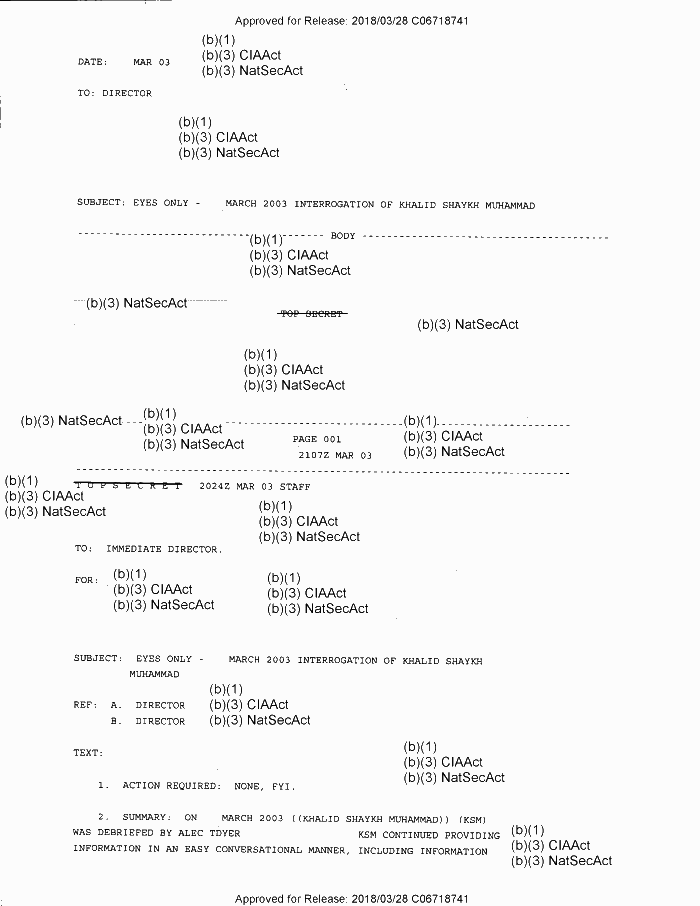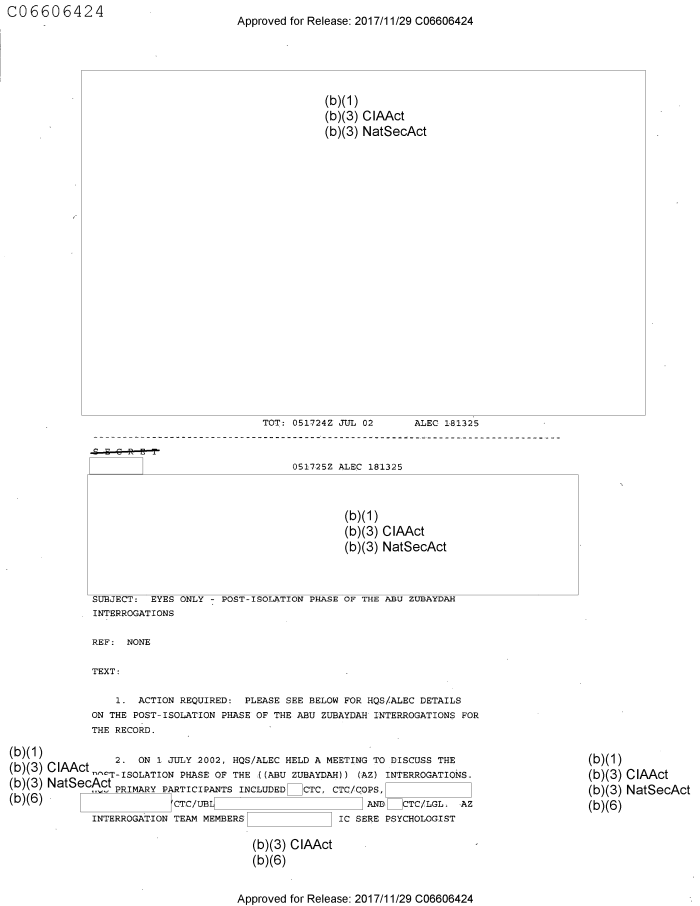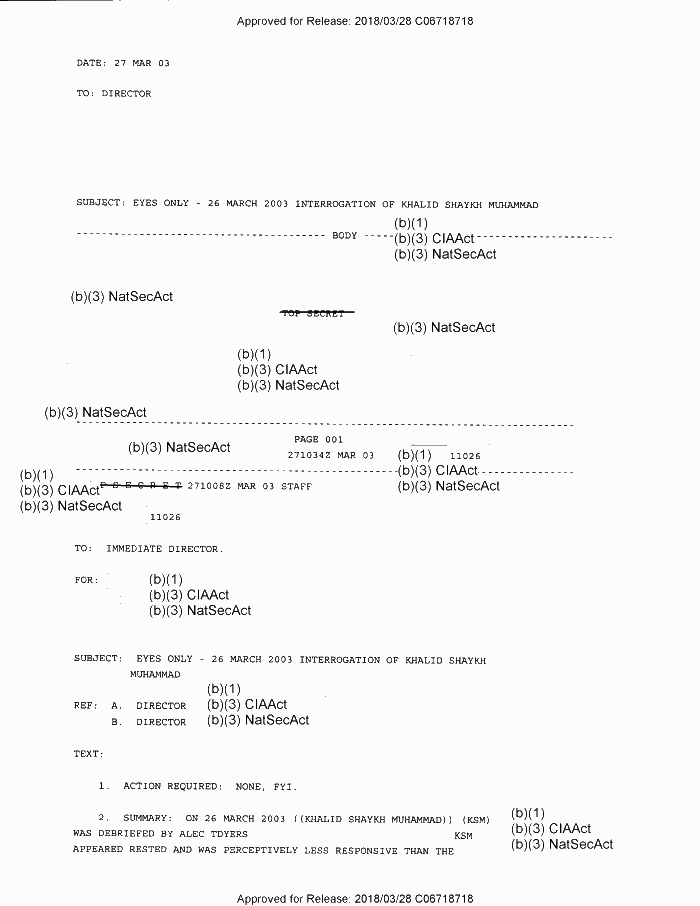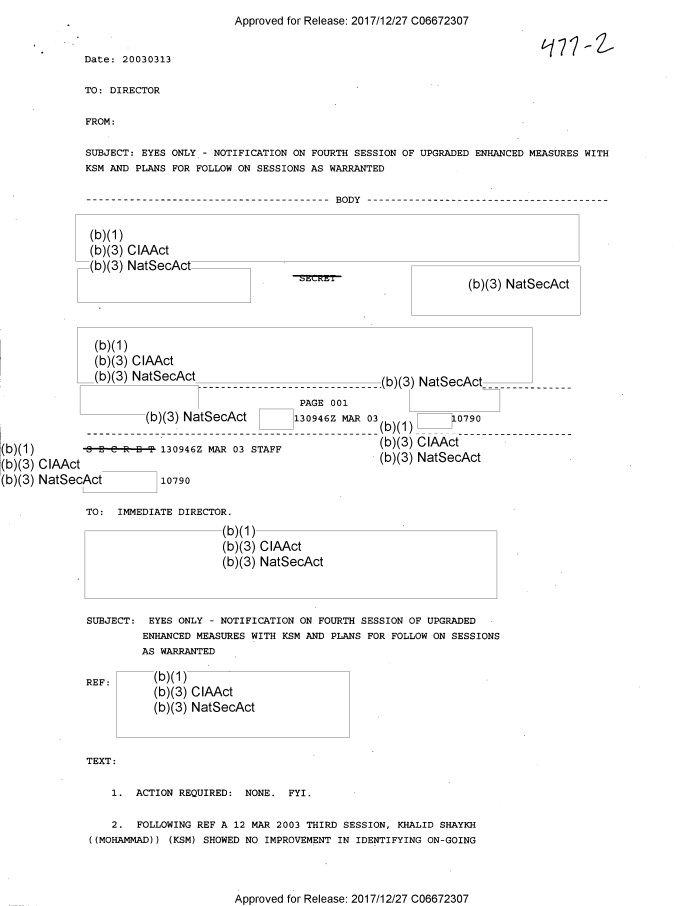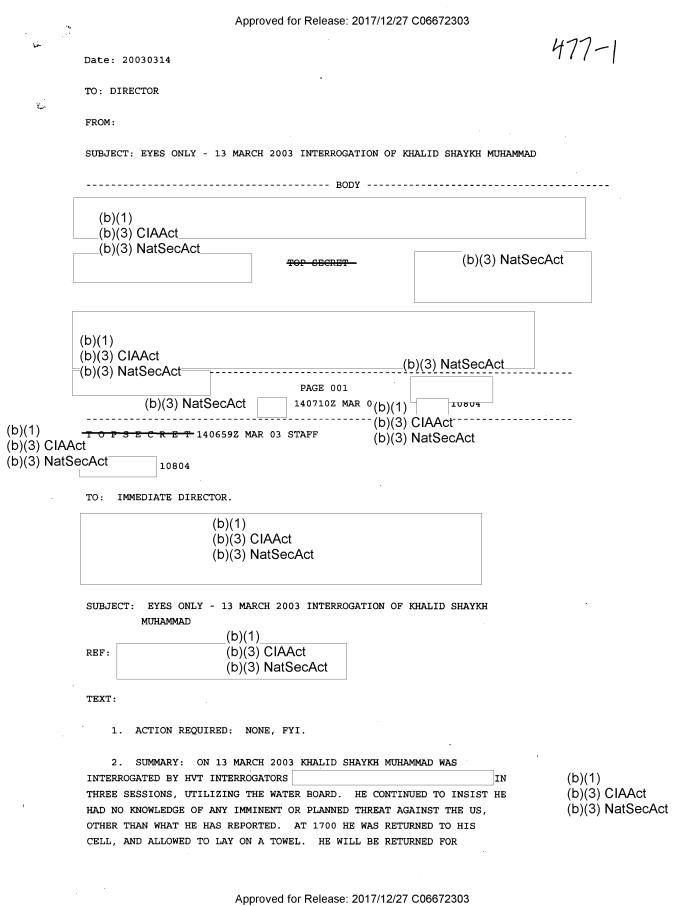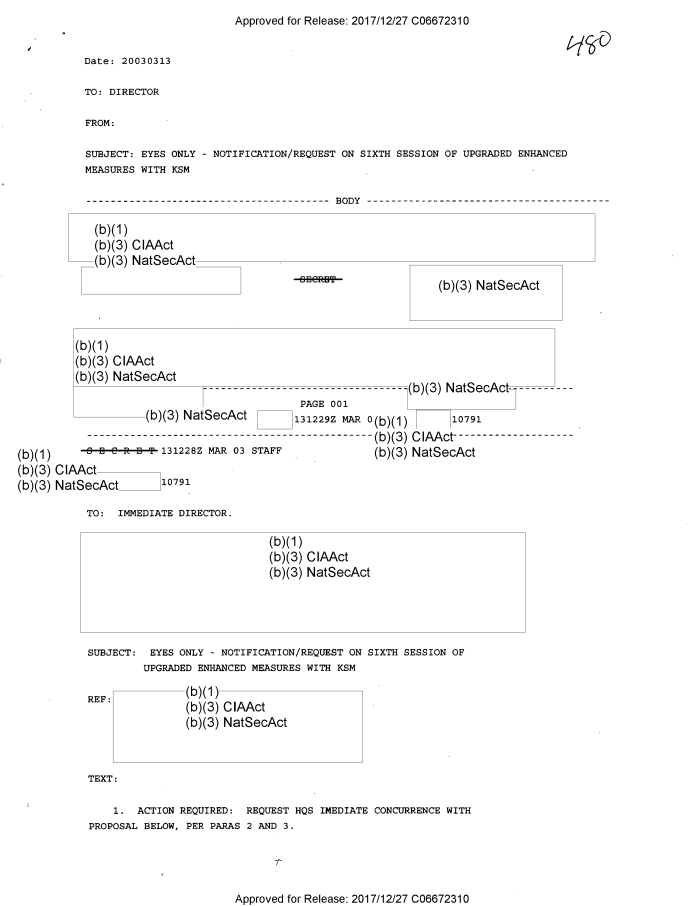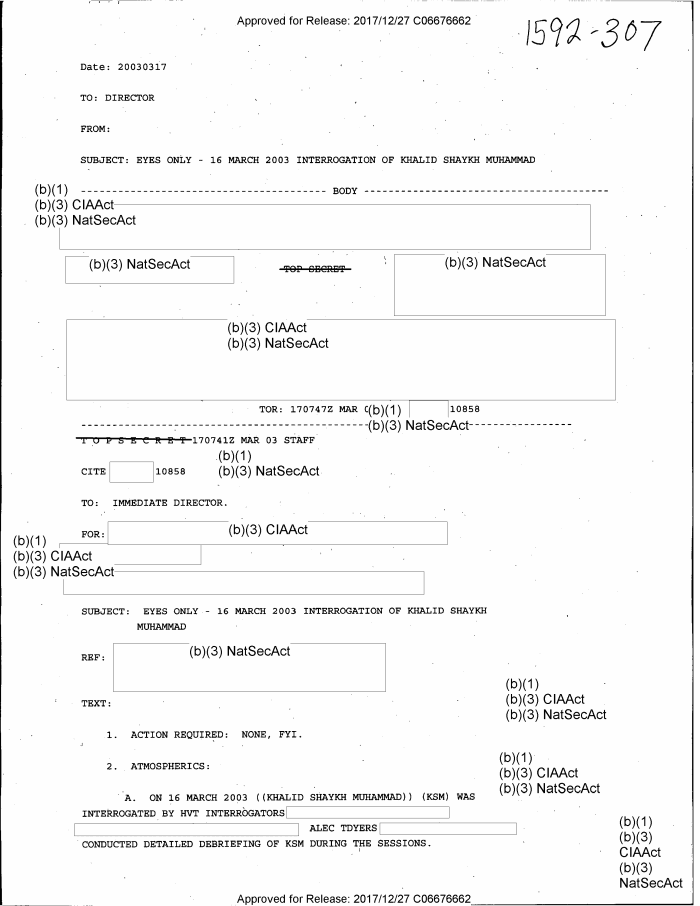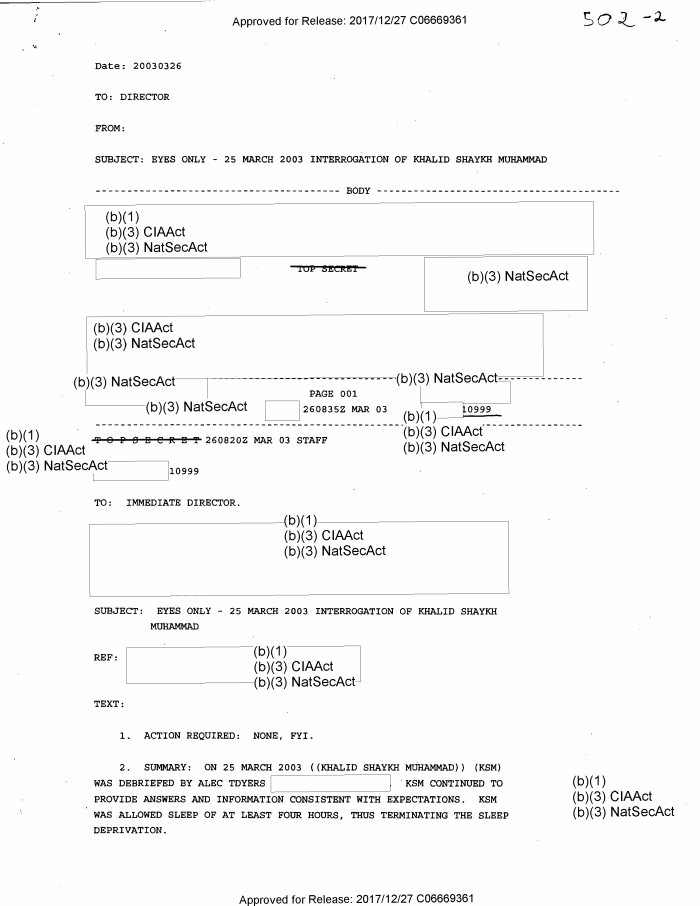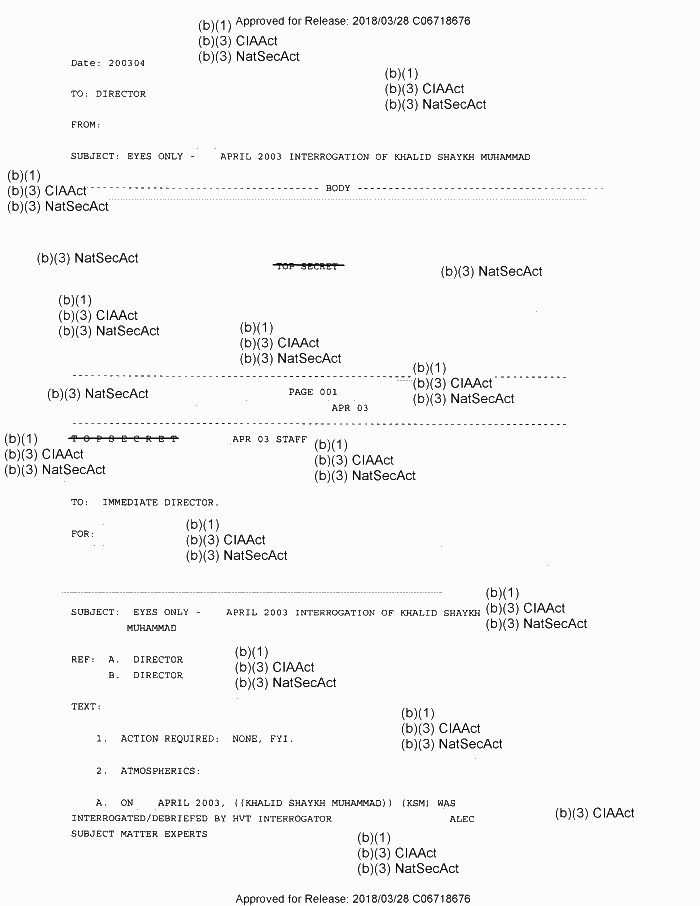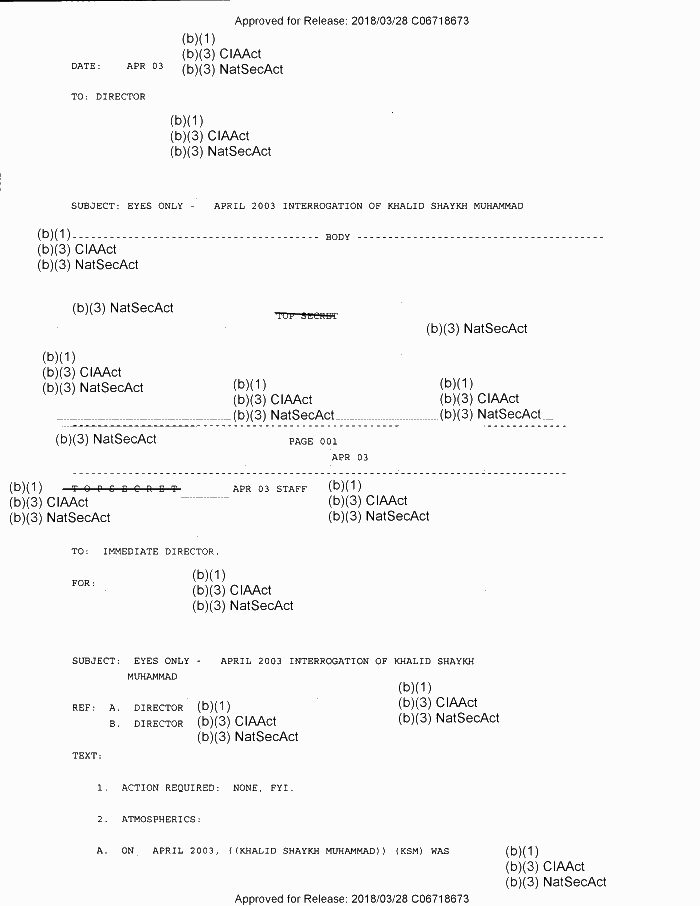Psychologists Open a Window on Brutal C.I.A. InterrogationsA lawsuit filed on behalf of former prisoners reveals new details about a program that used techniques widely viewed as torture.By SHERI FINK and JAMES RISEN
JUNE 21, 2017
Fifteen years after he helped devise the brutal interrogation techniques used on terrorism suspects in secret C.I.A. prisons, John Bruce Jessen, a former military psychologist, expressed ambivalence about the program.
He described himself and a fellow military psychologist, James Mitchell, as reluctant participants in using the techniques, some of which are widely viewed as torture, but also justified the practices as effective in getting resistant detainees to cooperate.
“I think any normal, conscionable man would have to consider carefully doing something like this,” Dr. Jessen said in a newly disclosed deposition. “I deliberated with great, soulful torment about this, and obviously I concluded that it could be done safely or I wouldn’t have done it.”
The two psychologists — whom C.I.A. officials have called architects of the interrogation program, a designation they dispute — are defendants in the only lawsuit that may hold participants accountable for causing harm.
The program has been well documented, but under deposition, with a camera focused on their faces, Drs. Jessen and Mitchell provided new details about the interrogation effort, their roles in it and their rationales. Their accounts were sometimes at odds with their own correspondence at the time, as well as previous portrayals of them by officials and other interrogators as eager participants in the program.
Read the Case Documents
Linked below are PDF transcripts of the depositions and other declassified agency documents.
CIA Cables
CIA Interrogation Plan
James E. Mitchell
John B. Jessen
John Rizzo
Jose Rodriguez
Mohamed Ahmed Ben Soud
Obaidullah
Suleiman Abdullah Salim
The suit, filed in Federal District Court in Spokane, Wash., was brought by the American Civil Liberties Union on behalf of several former prisoners of the Central Intelligence Agency. The New York Times has obtained the video depositions of Dr. Jessen and Dr. Mitchell, as well as those of two former C.I.A. officials and two former detainees. Newly declassified agency documents have also been released in the case.
Revelations about the C.I.A. practices, which were a radical departure for the United States, set off global denunciations and bitter divisions at home. They led to an eventual ban on the techniques and a prohibition by the American Psychological Association against members’ participation in national security interrogations. A 2014 Senate Intelligence Committee report condemned the interrogation techniques as torture and ineffective in providing useful intelligence.
For years, Dr. Mitchell, polished and assertive, has defended the two men’s actions in the press and in a recent book, while Dr. Jessen remained silent. But Dr. Jessen answered questions under oath on Jan. 20, the same day that President Trump was inaugurated. During the election campaign Mr. Trump had pledged to revive the use of torture, including waterboarding, though he later backed off.
The two psychologists argue that the C.I.A., for which they were contractors, controlled the program. But it is difficult to successfully sue agency officials because of government immunity.
Under the agency’s direction, the two men said, they proposed the “enhanced interrogation” techniques — which were then authorized by the Justice Department — applied them and trained others to do so. Their business received $81 million from the agency.
PLAY VIDEO 2:02
Video depositions in a case brought by former C.I.A. detainees give an insight into the almost informal beginnings of the agency's enhanced interrogation programme. Malachy Browne and Natalie Reneau
But in his deposition, Dr. Jessen indicated that the two men had some reservations. “Jim and I didn’t want to continue doing what we were doing,” Dr. Jessen testified. “We tried to get out several times and they needed us, and we — we kept going.”
The outline for the techniques emerged in 2002 when C.I.A. officials asked them to come up with proposals. The techniques were largely adapted from those the psychologists had used to train American soldiers in survival schools to resist brutal interrogations by hostile forces that were violating the laws of war.
“Jim and I went into a cubicle,” Dr. Jessen said. “He sat down at a typewriter and together we wrote out a list.” They thought those techniques — including sensory and sleep deprivation, shackling for hours in uncomfortable positions and waterboarding — would be safer than others the C.I.A. might consider to get resistant detainees to provide information that could help head off another terrorist attack, he said.
Lasting Scars
Articles in this series examine the American legacy of brutal interrogations.
How U.S. Torture Left a Legacy of Damaged Minds
After Torture, Ex-Detainee Is Still Captive of ‘The Darkness’
Where Even Nightmares Are Classified: Psychiatric Care at Guantánamo
Secret Documents Show a Tortured Prisoner's Descent
Memories of a Secret C.I.A. Prison
Soon after, the C.I.A. asked them to use the techniques to interrogate a terrorism suspect, something with which they had no experience.
“I had been in the military my whole life and — and I was committed to and used to doing what I was ordered to do,” Dr. Jessen said. “That’s the way I considered this circumstance.”
Abu Zubaydah, taken into custody in 2002, was the first detainee to be waterboarded. The United States government believed he was a top leader of Al Qaeda, though it later abandoned that claim.
At a secret C.I.A. jail in Thailand, he provided useful intelligence to F.B.I. agents who questioned him using traditional methods, including rapport-building. But worried that he was holding back information, which the C.I.A. later concluded he never had, agency leaders chose to use extreme physical force to break him.
Drs. Mitchell and Jessen were sent to the jail to carry out the techniques, including waterboarding. Water was poured over a cloth covering Abu Zubaydah’s face to simulate drowning. He underwent the procedure 83 times over a period of days; at one point he was completely unresponsive, with bubbles rising from his mouth, according to the Senate report. A newly declassified August 2002 cable from the prison to headquarters noted: “At the onset of involuntary stomach and leg spasms, subject was again elevated to clear his airway, which was followed by hysterical pleas. Subject was distressed to the level that he was unable to effectively communicate or adequately engage the team.”
AUDIO
Listen to ‘The Daily’
What we’ve learned about the C.I.A.’s “enhanced interrogation” techniques from a lawsuit that seeks to hold two psychologists accountable.
ART19
When those at the prison wanted to end the waterboarding sessions as no longer useful, C.I.A. supervisors — including Jose Rodriguez, then the head of the agency’s Counterterrorism Center and a witness who testified under oath in the lawsuit — ordered them to continue.
“They kept telling me every day a nuclear bomb was going to be exploded in the United States and that because I had told them to stop, I had lost my nerve and it was going to be my fault if I didn’t continue,” Dr. Jessen testified.
Dr. Mitchell said that the C.I.A. officials told them: “‘You guys have lost your spine.’ I think the word that was actually used is that you guys are pussies. There was going to be another attack in America and the blood of dead civilians are going to be on your hands.”
A plaintiff, Mohamed Ben Soud, drew pictures depicting his treatment in a C.I.A. prison. They included, left, being placed in a wooden box and poked through its holes and, right, being strapped to a wooden board on which he was abused with water. via ACLU
Still, the psychologists’ interrogation team recommended using the aggressive techniques as a “template for future interrogations of high-value captives,” according to an agency cable. The psychologists later subjected two other prisoners — Abd al-Rahim al-Nashiri and Khalid Sheikh Mohammed — to waterboarding.
In his deposition, Dr. Mitchell, who once said that most people would prefer to have their legs broken than to be waterboarded, disagreed with a lawyer’s reference to the practice as painful. “It sucks, you know. I don’t know that it’s painful,” he said. “I’m using the word distressing.”
Both Dr. Jessen and Dr. Mitchell rejected any notion that men subjected to the harsh techniques suffered any long-term physical or psychological damage. “If they are out there and that happened, then, you know, show me the data,” Dr. Mitchell said. He added that if the techniques were applied as recommended, “my view is, that is so unlikely so as to be impossible.”
But The Times last year found a pattern of long-term psychological damage among dozens of former detainees subjected to brutal treatment by the United States. The men described grappling with depression, anxiety, withdrawal and flashbacks.
Mohamed Ben Soud, a Libyan, was held by the C.I.A. in Afghanistan. Holly Pickett/ACLU
In their depositions, two former prisoners who are plaintiffs in the lawsuit described their torment. Drs. Mitchell and Jessen said they had not interrogated or encountered the two men.
Mohamed Ben Soud, a Libyan, was held by the C.I.A. in Afghanistan and was subjected to being locked in small boxes, slammed against a wall and doused with buckets of ice water while naked and shackled. He said he still suffered from nightmares, fear, mood swings and other psychological injuries as a result of his captivity.
“It comes to me during my sleep and as if I’m still imprisoned in that horrible place and still shackled,” he said in his deposition, through a translator. “I get the feeling of worry about my future and about the fear that this could happen again.”
Suleiman Salim, a Tanzanian captured in 2003 and also held by the C.I.A. in Afghanistan, was beaten, isolated in a dark cell for months, subjected to dousing with water and deprived of sleep. He said he suffered from flashbacks, headaches, sleeplessness and ringing in his ears.
“I don’t feel like being with people, I like being with myself, and I don’t like walking around to see people,” he said in his deposition, also through a translator. “I feel like I’m so weak and I can’t do anything.”
Suleiman Salim, a Tanzanian, was captured in 2003 and held by the C.I.A. in Afghanistan. He was beaten, isolated in a dark cell for months, subjected to dousing with water and deprived of sleep. Bryan Denton for The New York Times
Dr. Jessen said that after the C.I.A.’s secret detention program became public — it was officially acknowledged by President George W. Bush in 2006, but had been previously described in news reports — he and Dr. Mitchell were asked for guidance about which methods could be eliminated. They also deliberated “damn near every day how we could help our government and not do the things we were doing,” Dr. Jessen said. He said they developed an alternative involving less physical coercion, but never had the chance to put it into practice. He would not provide details because the plans remain classified.
Still, Dr. Mitchell asserted that the current legal limits on interrogation methods were too restrictive, and both men said that some of the physically harsh techniques were useful. “Walling,” in which a prisoner is repeatedly slammed against a flexible plywood wall, was “one of the most effective,” Dr. Jessen said. “It’s discombobulating. It doesn’t hurt you, but it jostles the inner ear, it makes a really loud noise.”
He also described extreme sleep deprivation: “There is a tether anchored to the ceiling in the center of the detention cell. The detainee has handcuffs and they’re attached to the tether in a way that they can’t lie down or rest against a wall. They’re monitored to make sure they don’t get edema if they hang on the cuffs too much.”
Mr. Salim, responding to questions about the same technique, described it as excruciating: “A lot of pain in my arms, a lot of pains in my back and around my waist.”
In his deposition, Dr. Mitchell revealed that he, along with others, urged the C.I.A. to destroy videotapes the agency had made of some interrogations. The destruction of the tapes became the subject of investigations both by the Justice Department and Congress.
Got a confidential news tip?
Learn More
Dr. Mitchell explained his reasoning about the graphic images of waterboarding and other practices: “I thought they were ugly and they would, you know, potentially endanger our lives by putting our pictures out so that the bad guys could see us.”
Both men denied accusations that they evaluated the effectiveness of the methods they promoted. However, the advocacy group Physicians for Human Rights, in a report being released this week, contends that the men and the C.I.A. engaged in unethical experimentation on detainees, which is banned by the Nuremberg Code for health professionals developed after World War II.
The group said the explicit mention of applied research in the psychologists’ contracts with the agency, released recently through the lawsuit, and similar references in recently released C.I.A. cables, indicate that the enhanced interrogation program “was itself an applied research regime and implicitly conceptualized as such by the C.I.A.”
Gul Rahman died in C.I.A. custody in Afghanistan in 2002. His estate is a plaintiff in the lawsuit brought by the A.C.L.U. and the Gibbons law firm. Habib Rahman
The American Civil Liberties Union and the Gibbons law firm of Newark brought the lawsuit on behalf of Mr. Salim, Mr. Ben Soud and the estate of a third man, Gul Rahman, who died in C.I.A. custody in Afghanistan in 2002, most likely of hypothermia. Dr. Jessen, who participated in the prisoner’s interrogation, said he had asked guards several times to provide clothes and blankets to him.
The case is scheduled for trial on Sept. 5. Last month, both sides asked Judge Justin L. Quackenbush of Federal District Court to rule summarily in their favor. He declined to do so, but did grant the United States government’s request to block the deposition of two additional former C.I.A. officials as witnesses and the release of certain documents requested by Drs. Mitchell and Jessen, on grounds it could harm national security. However, the case was permitted to continue.
https://www.nytimes.com/interactive/201 ... rture.html 




